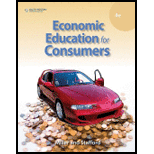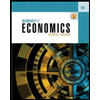
Economic Education For Consumers
4th Edition
ISBN: 9780538448888
Author: Roger LeRoy Miller, Alan D. Stafford
Publisher: Cengage Learning
expand_more
expand_more
format_list_bulleted
Question
Chapter 3, Problem 18TR
To determine
Analyze the given situation.
Expert Solution & Answer
Want to see the full answer?
Check out a sample textbook solution
Students have asked these similar questions
Exercise 3
The production function of a firm is described by the following equation Q=10,000-3L2 where L
stands for the units of labour.
a) Draw a graph for this equation. Use the quantity produced in the y-axis, and the units of labour in
the x-axis.
b) What is the maximum production level?
c) How many units of labour are needed at that point?
d) Provide one reference with you answer.
Exercise 1
Consider the market supply curve which passes through the intercept and from which the market
equilibrium data is known, this is, the price and quantity of equilibrium PE=50 and QE=2000.
Considering those two points, find the equation of the supply.
Draw a graph of this line.
Provide one reference with your answer.
Exercise 2
Considering the previous supply line, determine if the following demand function corresponds to the
market demand equilibrium stated above. QD=3000-2p.
Consider the market supply curve which passes through the intercept and from which the marketequilibrium data is known, this is, the price and quantity of equilibrium PE=50 and QE=2000.a. Considering those two points, find the equation of the supply. b. Draw a graph of this line.
Chapter 3 Solutions
Economic Education For Consumers
Ch. 3.1 - Prob. 1UCCh. 3.1 - Prob. 2UCCh. 3.1 - Prob. 3UCCh. 3.1 - Prob. 4UCCh. 3.1 - Prob. 5TCCh. 3.1 - Prob. 6TCCh. 3.1 - Prob. 7TCCh. 3.2 - Prob. 1UCCh. 3.2 - Prob. 2UCCh. 3.2 - Prob. 3UC
Ch. 3.2 - Prob. 4UCCh. 3.2 - Prob. 5UCCh. 3.2 - Prob. 6UCCh. 3.2 - Prob. 7UCCh. 3.2 - Prob. 8UCCh. 3.2 - Prob. 9TCCh. 3.2 - Prob. 10TCCh. 3.2 - Prob. 11TCCh. 3.2 - Prob. 12TCCh. 3.3 - Prob. 1UCCh. 3.3 - Prob. 2UCCh. 3.3 - Prob. 3UCCh. 3.3 - Prob. 4UCCh. 3.3 - Prob. 5UCCh. 3.3 - Prob. 6UCCh. 3.3 - Prob. 7UCCh. 3.3 - Prob. 8UCCh. 3.3 - Prob. 9UCCh. 3.3 - Prob. 10TCCh. 3.3 - Prob. 11TCCh. 3.3 - Prob. 12TCCh. 3.3 - Prob. 13TCCh. 3.3 - Prob. 14TCCh. 3.4 - Prob. 1UCCh. 3.4 - Prob. 2UCCh. 3.4 - Prob. 3UCCh. 3.4 - Prob. 4UCCh. 3.4 - Prob. 5UCCh. 3.4 - Prob. 6UCCh. 3.4 - Prob. 7TCCh. 3.4 - Prob. 8TCCh. 3.4 - Prob. 9TCCh. 3.4 - Prob. 10TCCh. 3 - Prob. 1TRCh. 3 - Prob. 2TRCh. 3 - Prob. 3TRCh. 3 - Prob. 4TRCh. 3 - Prob. 5TRCh. 3 - Prob. 6TRCh. 3 - Prob. 7TRCh. 3 - Prob. 8TRCh. 3 - Prob. 9TRCh. 3 - Prob. 10TRCh. 3 - Prob. 11TRCh. 3 - Prob. 12TRCh. 3 - Prob. 13TRCh. 3 - Prob. 14TRCh. 3 - Prob. 15TRCh. 3 - Prob. 16TRCh. 3 - Prob. 17TRCh. 3 - Prob. 18TRCh. 3 - Prob. 19TRCh. 3 - Prob. 20TRCh. 3 - Prob. 21TRCh. 3 - Prob. 22TRCh. 3 - Prob. 23TRCh. 3 - Prob. 24TRCh. 3 - Prob. 25TRCh. 3 - Prob. 26TRCh. 3 - Prob. 27TRCh. 3 - Prob. 28TRCh. 3 - Prob. 29TRCh. 3 - Prob. 30TRCh. 3 - Prob. 31TRCh. 3 - Prob. 32TR
Knowledge Booster
Similar questions
- Government Purchases and Tax Revenues A B GDP T₂ Refer to the diagram. Discretionary fiscal policy designed to slow the economy is illustrated by Multiple Choice the shift of curve T₁ to T2. a movement from d to balong curve T₁.arrow_forwardSection III: Empirical Findings: Descriptive Statistics and inferential statistics………………..40% Descriptive statistics provide details about the Y variable, based on the sample for the 10-year period. Here, you use Excell or manually compute Mean or the average income per capita. Interpret the meaning of average income per capita. Draw the line chart showing the educational performance over the time-period of your study. Label the Vertical axis as Y performance and X axis as the explanatory variable (X1) . Do the same thing between Y and X2 Empirical/ Inferential Statistics: Here, use the sample information to perform the following: Draw the Scatter plot and impose the trend line: showing the Y variable and explanatory variables ( X1). Draw the scatter plot and impose the tend line: Showing Y and X2. Does your evidence (data) support your theory? Refer to the trend line: Is the relationship positive or negative as expected? Based on the data sheet below: Years Y ( per…arrow_forwardSection III: Empirical Findings: Descriptive Statistics and inferential statistics………………..40% Descriptive statistics provide details about the Y variable, based on the sample for the 10-year period. Here, you use Excell or manually compute Mean or the average income per capita. Interpret the meaning of average income per capita. Draw the line chart showing the educational performance over the time-period of your study. Label the Vertical axis as Y performance and X axis as the explanatory variable (X1) . Do the same thing between Y and X2 Empirical/ Inferential Statistics: Here, use the sample information to perform the following: Draw the Scatter plot and impose the trend line: showing the Y variable and explanatory variables ( X1). Draw the scatter plot and impose the tend line: Showing Y and X2. Does your evidence (data) support your theory? Refer to the trend line: Is the relationship positive or negative as expected? Create graphs based on table below; Years Y ( per…arrow_forward
- Please help me with this Accounting questionarrow_forwardTitle: Does the educational performance depend on its literacy rate and government spending over the last 10 years? In the introduction, there are four things to include:a) Clearly state your research topic follows by country’s background in terms of (population density; male/female ratio; and identify the problem leading up to the study of it, such as government spending and adult literacy rate. How does the US perform compared to other countries.b) State the research question that you wish to resolve: Does the US economic performance depend on its government spending on education and the literacy rate over the last 10 years. Define performance (Y) as the average income per capita, an indicator of the country’s economy growing over time. For example, an increase in government spending leads to higher literacy rates and subsequently higher productivity in the economy. Also, mention that you will use a sample size of 10 years of secondary data from the existing literature,…arrow_forwardTitle: Does the educational performance depend on its literacy rate and government spending over the last 10 years? In the introduction, there are four things to include:a) Clearly state your research topic follows by country’s background in terms of (population density; male/female ratio; and identify the problem leading up to the study of it, such as government spending and adult literacy rate. How does the US perform compared to other countries.b) State the research question that you wish to resolve: Does the US economic performance depend on its government spending on education and the literacy rate over the last 10 years. Define performance (Y) as the average income per capita, an indicator of the country’s economy growing over time. For example, an increase in government spending leads to higher literacy rates and subsequently higher productivity in the economy. Also, mention that you will use a sample size of 10 years of secondary data from the existing literature,…arrow_forward
- Explain how the introduction of egg replacers and plant-based egg products will impact the bakery industry. Provide a graphical representation.arrow_forwardExplain Professor Frederick's "cognitive reflection" test.arrow_forward11:44 Fri Apr 4 Would+You+Take+the+Bird+in+the+Hand Would You Take the Bird in the Hand, or a 75% Chance at the Two in the Bush? BY VIRGINIA POSTREL WOULD you rather have $1,000 for sure or a 90 percent chance of $5,000? A guaranteed $1,000 or a 75 percent chance of $4,000? In economic theory, questions like these have no right or wrong answers. Even if a gamble is mathematically more valuable a 75 percent chance of $4,000 has an expected value of $3,000, for instance someone may still prefer a sure thing. People have different tastes for risk, just as they have different tastes for ice cream or paint colors. The same is true for waiting: Would you rather have $400 now or $100 every year for 10 years? How about $3,400 this month or $3,800 next month? Different people will answer differently. Economists generally accept those differences without further explanation, while decision researchers tend to focus on average behavior. In decision research, individual differences "are regarded…arrow_forward
- Describe the various measures used to assess poverty and economic inequality. Analyze the causes and consequences of poverty and inequality, and discuss potential policies and programs aimed at reducing them, assess the adequacy of current environmental regulations in addressing negative externalities. analyze the role of labor unions in labor markets. What is one benefit, and one challenge associated with labor unions.arrow_forwardEvaluate the effectiveness of supply and demand models in predicting labor market outcomes. Justify your assessment with specific examples from real-world labor markets.arrow_forwardExplain the difference between Microeconomics and Macroeconomics? 2.) Explain what fiscal policy is and then explain what Monetary Policy is? 3.) Why is opportunity cost and give one example from your own of opportunity cost. 4.) What are models and what model did we already discuss in class? 5.) What is meant by scarcity of resources?arrow_forward
arrow_back_ios
SEE MORE QUESTIONS
arrow_forward_ios
Recommended textbooks for you
 Economics Today and Tomorrow, Student EditionEconomicsISBN:9780078747663Author:McGraw-HillPublisher:Glencoe/McGraw-Hill School Pub Co
Economics Today and Tomorrow, Student EditionEconomicsISBN:9780078747663Author:McGraw-HillPublisher:Glencoe/McGraw-Hill School Pub Co
 Managerial Economics: A Problem Solving ApproachEconomicsISBN:9781337106665Author:Luke M. Froeb, Brian T. McCann, Michael R. Ward, Mike ShorPublisher:Cengage Learning
Managerial Economics: A Problem Solving ApproachEconomicsISBN:9781337106665Author:Luke M. Froeb, Brian T. McCann, Michael R. Ward, Mike ShorPublisher:Cengage Learning Survey of Economics (MindTap Course List)EconomicsISBN:9781305260948Author:Irvin B. TuckerPublisher:Cengage Learning
Survey of Economics (MindTap Course List)EconomicsISBN:9781305260948Author:Irvin B. TuckerPublisher:Cengage Learning Microeconomics: Principles & PolicyEconomicsISBN:9781337794992Author:William J. Baumol, Alan S. Blinder, John L. SolowPublisher:Cengage Learning
Microeconomics: Principles & PolicyEconomicsISBN:9781337794992Author:William J. Baumol, Alan S. Blinder, John L. SolowPublisher:Cengage Learning Microeconomics: Private and Public Choice (MindTa...EconomicsISBN:9781305506893Author:James D. Gwartney, Richard L. Stroup, Russell S. Sobel, David A. MacphersonPublisher:Cengage Learning
Microeconomics: Private and Public Choice (MindTa...EconomicsISBN:9781305506893Author:James D. Gwartney, Richard L. Stroup, Russell S. Sobel, David A. MacphersonPublisher:Cengage Learning

Economics Today and Tomorrow, Student Edition
Economics
ISBN:9780078747663
Author:McGraw-Hill
Publisher:Glencoe/McGraw-Hill School Pub Co


Managerial Economics: A Problem Solving Approach
Economics
ISBN:9781337106665
Author:Luke M. Froeb, Brian T. McCann, Michael R. Ward, Mike Shor
Publisher:Cengage Learning

Survey of Economics (MindTap Course List)
Economics
ISBN:9781305260948
Author:Irvin B. Tucker
Publisher:Cengage Learning

Microeconomics: Principles & Policy
Economics
ISBN:9781337794992
Author:William J. Baumol, Alan S. Blinder, John L. Solow
Publisher:Cengage Learning

Microeconomics: Private and Public Choice (MindTa...
Economics
ISBN:9781305506893
Author:James D. Gwartney, Richard L. Stroup, Russell S. Sobel, David A. Macpherson
Publisher:Cengage Learning